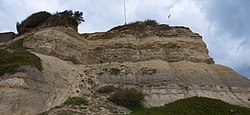| Wealden Group | |
|---|---|
| Stratigraphic range: Late Berriasian-Aptian, | |
 Coastal exposure of the Wealden Group near Bexhill-on-Sea | |
| Type | Group |
| Sub-units | |
| Underlies | Lower Greensand Group |
| Overlies | Purbeck Group |
| Thickness | Up to 850 m in Weald Basin, c. 500 m in Wessex basin, few m in marginal areas |
| Location | |
| Region | England |
| Country | |
| Type section | |
| Named for | Weald |
The Wealden Group, occasionally also referred to as the Wealden Supergroup, is a group (a sequence of rock strata) in the lithostratigraphy of southern England. The Wealden group consists of paralic to continental (freshwater) facies sedimentary rocks of Berriasian to Aptian age and thus forms part of the English Lower Cretaceous. It is composed of alternating sands and clays. The sandy units were deposited in a flood plain of braided rivers, the clays mostly in a lagoonal coastal plain.[1]
The Wealden Group can be found in almost all Early Cretaceous basins of England: its outcrops curve from the Wessex Basin in the south to the Cleveland Basin in the northeast. It is not found in northwest England and Wales, areas which were at the time tectonic highs where no deposition took place. The same is true for the London Platform around London and Essex. Offshore, the Wealden Group can reach a thickness of 700 metres.[1] The terms Wealden and Wealden facies are also used as generic terms referring to Early Cretaceous non-marine sequences elsewhere in Europe.